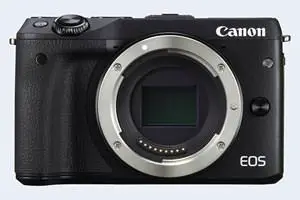Canon 1300D vs M3
The Canon EOS 1300D (called Canon T6 in some regions) and the Canon EOS M3 are two digital cameras that were officially introduced, respectively, in March 2016 and February 2015. The 1300D is a DSLR, while the M3 is a mirrorless interchangeable lens camera. Both cameras are equipped with an APS-C sensor. The 1300D has a resolution of 17.9 megapixels, whereas the M3 provides 24 MP.
Below is an overview of the main specs of the two cameras as a starting point for the comparison.

Check 1300D offers at
ebay.com

Check M3 offers at
ebay.com
Going beyond this snapshot of core features and characteristics, what are the differences between the Canon EOS 1300D and the Canon EOS M3? Which one should you buy? Read on to find out how these two cameras compare with respect to their body size, their imaging sensors, their shooting features, their input-output connections, and their reception by expert reviewers.
Body comparison
The side-by-side display below illustrates the physical size and weight of the Canon 1300D and the Canon M3. The two cameras are presented according to their relative size. Three consecutive perspectives from the front, the top, and the back are available. All width, height and depth measures are rounded to the nearest millimeter.
The M3 can be obtained in two different colors (black, white), while the 1300D is only available in black.
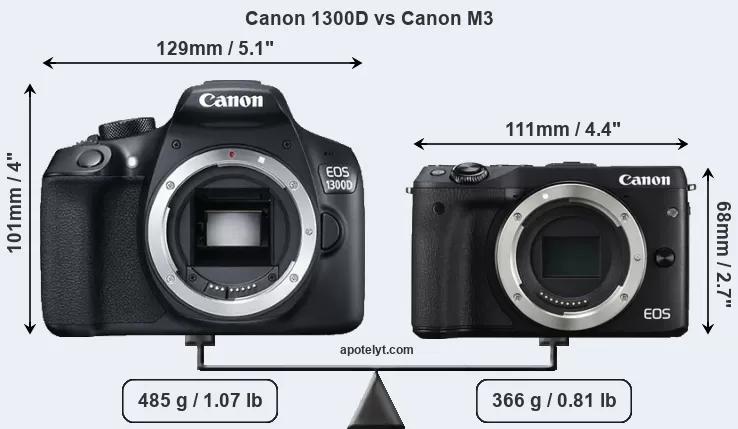
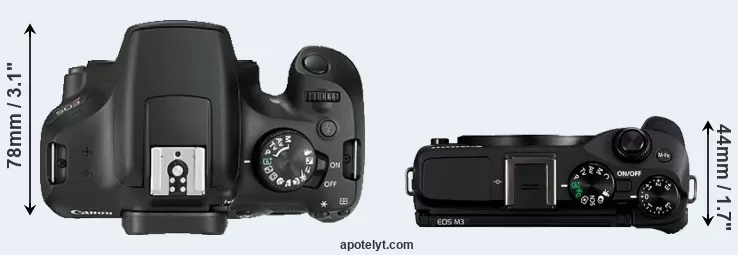
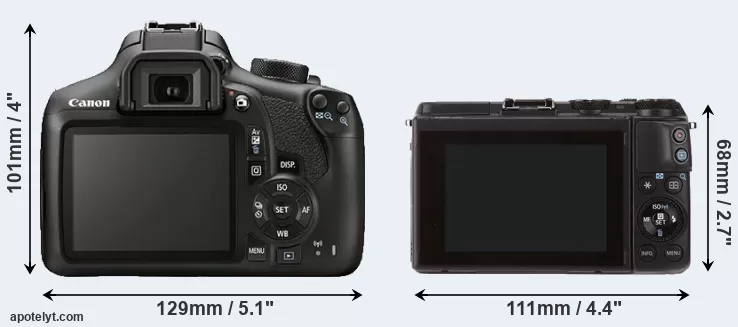
If the front view area (width x height) of the cameras is taken as an aggregate measure of their size, the Canon M3 is considerably smaller (42 percent) than the Canon 1300D. Moreover, the M3 is markedly lighter (25 percent) than the 1300D. In this context, it is worth noting that neither the 1300D nor the M3 are weather-sealed.
The above size and weight comparisons are to some extent incomplete since they do not consider the interchangeable lenses that both of these cameras require. Hence, you might want to study and compare the specifications of available lenses in order to get the full picture of the size and weight of the two camera systems.
Concerning battery life, the 1300D gets 500 shots out of its Canon LP-E10 battery, while the M3 can take 250 images on a single charge of its Canon LP-E17 power pack.
The following table provides a synthesis of the main physical specifications of the two cameras and other similar ones. If you would like to visualize and compare a different camera combination, you can navigate to the CAM-parator app and make your selection from a broad list of cameras there.

| Camera Model |
Camera Width |
Camera Height |
Camera Depth |
Camera Weight |
Battery Life |
Weather Sealing |
Camera Launch |
Launch Price |
Street Price |
||
|---|---|---|---|---|---|---|---|---|---|---|---|
| 1. | Canon 1300D | 129 mm | 101 mm | 78 mm | 485 g | 500 | n | Mar 2016 | US$ 449 | ebay.com | |
| 2. | Canon M3 | 111 mm | 68 mm | 44 mm | 366 g | 250 | n | Feb 2015 | US$ 679 | ebay.com | |
| 3. | Canon 100D | 117 mm | 91 mm | 69 mm | 407 g | 380 | n | Mar 2013 | US$ 549 | ebay.com | |
| 4. | Canon 700D | 133 mm | 100 mm | 79 mm | 580 g | 440 | n | Mar 2013 | US$ 649 | ebay.com | |
| 5. | Canon 750D | 132 mm | 101 mm | 78 mm | 555 g | 440 | n | Feb 2015 | US$ 749 | ebay.com | |
| 6. | Canon 760D | 132 mm | 101 mm | 78 mm | 565 g | 440 | n | Feb 2015 | US$ 649 | ebay.com | |
| 7. | Canon 1200D | 130 mm | 100 mm | 78 mm | 480 g | 500 | n | Feb 2014 | US$ 449 | ebay.com | |
| 8. | Canon 2000D | 129 mm | 101 mm | 78 mm | 475 g | 500 | n | Feb 2018 | US$ 449 | amazon.com | |
| 9. | Canon 4000D | 129 mm | 102 mm | 77 mm | 436 g | 500 | n | Feb 2018 | US$ 399 | amazon.com | |
| 10. | Canon M5 | 116 mm | 89 mm | 61 mm | 427 g | 295 | n | Sep 2016 | US$ 979 | ebay.com | |
| 11. | Canon M6 | 112 mm | 68 mm | 45 mm | 390 g | 295 | n | Feb 2017 | US$ 779 | ebay.com | |
| 12. | Canon M10 | 108 mm | 67 mm | 35 mm | 301 g | 255 | n | Oct 2015 | US$ 499 | ebay.com | |
| 13. | Canon M100 | 108 mm | 67 mm | 35 mm | 302 g | 295 | n | Aug 2017 | US$ 499 | ebay.com | |
| 14. | Canon SX530 | 120 mm | 82 mm | 92 mm | 442 g | 210 | n | Jan 2015 | US$ 429 | ebay.com | |
| 15. | Canon SX540 | 120 mm | 82 mm | 92 mm | 442 g | 205 | n | Jan 2016 | US$ 399 | ebay.com | |
| 16. | Canon T6i | 132 mm | 101 mm | 78 mm | 555 g | 440 | n | Feb 2015 | US$ 749 | ebay.com | |
| 17. | Canon T6s | 132 mm | 101 mm | 78 mm | 565 g | 440 | n | Feb 2015 | US$ 649 | ebay.com | |
| Note: Measurements and pricing do not include easily detachable parts, such as add-on or interchangeable lenses or optional viewfinders. | |||||||||||
Any camera decision will naturally be influenced heavily by the price. The retail prices at the time of the camera’s release place the model in the market relative to other models in the producer’s line-up and the competition. The 1300D was launched at a markedly lower price (by 34 percent) than the M3, which puts it into a different market segment. Usually, retail prices stay at first close to the launch price, but after several months, discounts become available. Later in the product cycle and, in particular, when the replacement model is about to appear, further discounting and stock clearance sales often push the camera price considerably down. Then, after the new model is out, very good deals can frequently be found on the pre-owned market.
Sensor comparison
The size of the sensor inside a digital camera is one of the key determinants of image quality. All other things equal, a large sensor will have larger individual pixel-units that offer better low-light sensitivity, wider dynamic range, and richer color-depth than smaller pixels in a sensor of the same technological generation. Furthermore, a large sensor camera will give the photographer more possibilities to use shallow depth-of-field in order to isolate a subject from the background. On the downside, larger sensors tend to be associated with larger, more expensive camera bodies and lenses.
Both cameras under consideration feature an APS-C sensor and have a format factor (sometimes also referred to as "crop factor") of 1.6. Within the spectrum of camera sensors, this places the review cameras among the medium-sized sensor cameras that aim to strike a balance between image quality and portability. Both cameras have a native aspect ratio (sensor width to sensor height) of 3:2.
Technology-wise, the M3 uses a more advanced image processing engine (DIGIC 6) than the 1300D (DIGIC 4+), with benefits for noise reduction, color accuracy, and processing speed.
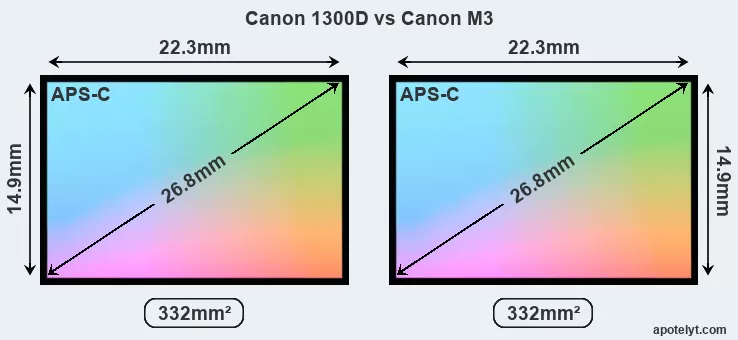
While the two cameras under review share the same sensor size, the M3 offers a higher resolution of 24 megapixels, compared with 17.9 MP of the 1300D. This megapixels advantage translates into a 16 percent gain in linear resolution. On the other hand, these sensor specs imply that the M3 has a higher pixel density and a smaller size of the individual pixel (with a pixel pitch of 3.72μm versus 4.31μm for the 1300D). Moreover, it should be noted, that the 1300D is a somewhat more recent model (by 1 year and 1 month) than the M3, and its sensor might have benefitted from technological advances during this time that further enhance the light gathering capacity of individual pixels.
The resolution advantage of the Canon M3 implies greater flexibility for cropping images or the possibility to print larger pictures. The maximum print size of the M3 for good quality output (200 dots per inch) amounts to 30 x 20 inches or 76.2 x 50.8 cm, for very good quality (250 dpi) 24 x 16 inches or 61 x 40.6 cm, and for excellent quality (300 dpi) 20 x 13.3 inches or 50.8 x 33.9 cm. The corresponding values for the Canon 1300D are 25.9 x 17.3 inches or 65.8 x 43.9 cm for good quality, 20.7 x 13.8 inches or 52.7 x 35.1 cm for very good quality, and 17.3 x 11.5 inches or 43.9 x 29.3 cm for excellent quality prints.
The M3 has on-sensor phase detect pixels, which results in fast and reliable autofocus acquisition even during live view operation.
The Canon EOS 1300D has a native sensitivity range from ISO 100 to ISO 6400, which can be extended to ISO 100-12800. The corresponding ISO settings for the Canon EOS M3 are ISO 100 to ISO 12800, with the possibility to increase the ISO range to 100-25600.
Technology-wise, both cameras are equipped with CMOS (Complementary Metal–Oxide–Semiconductor) sensors. Both cameras use a Bayer filter for capturing RGB colors on a square grid of photosensors. This arrangement is found in most digital cameras.
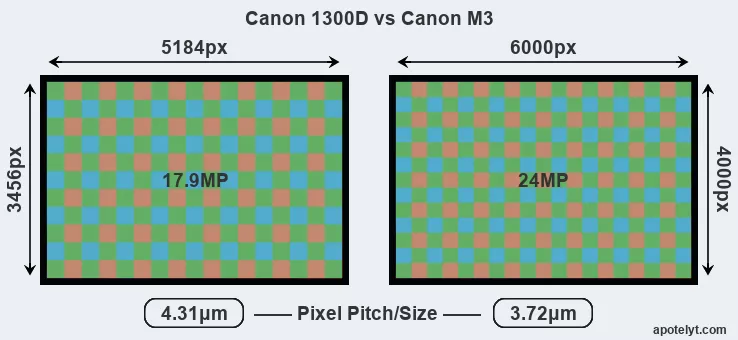
Since 2007, DXO Mark has published sensor performance measurements that have been derived using a consistent methodology. This service is based on lab testing and assigns an overall score to each camera sensor, as well as ratings for dynamic range ("DXO Landscape"), color depth ("DXO Portrait"), and low-light sensitivity ("DXO Sports"). Of the two cameras under consideration, the M3 has a markedly higher DXO score than the 1300D (overall score 6 points higher), which will translate into better image quality. The advantage is based on 0.8 bits higher color depth, 0.1 EV in additional dynamic range, and 0.6 stops in additional low light sensitivity. The adjacent table reports on the physical sensor characteristics and the outcomes of the DXO sensor quality tests for a sample of comparator-cameras.

| Camera Model |
Sensor Class |
Resolution (MP) |
Horiz. Pixels |
Vert. Pixels |
Video Format |
DXO Portrait |
DXO Landscape |
DXO Sports |
DXO Overall |
||
|---|---|---|---|---|---|---|---|---|---|---|---|
| 1. | Canon 1300D | APS-C | 17.9 | 5184 | 3456 | 1080/30p | 22.0 | 11.7 | 781 | 66 | |
| 2. | Canon M3 | APS-C | 24.0 | 6000 | 4000 | 1080/30p | 22.8 | 11.8 | 1169 | 72 | |
| 3. | Canon 100D | APS-C | 17.9 | 5184 | 3456 | 1080/30p | 21.8 | 11.3 | 843 | 63 | |
| 4. | Canon 700D | APS-C | 17.9 | 5184 | 3456 | 1080/30p | 21.7 | 11.2 | 681 | 61 | |
| 5. | Canon 750D | APS-C | 24.0 | 6000 | 4000 | 1080/30p | 22.7 | 12.0 | 919 | 71 | |
| 6. | Canon 760D | APS-C | 24.0 | 6000 | 4000 | 1080/30p | 22.6 | 12.0 | 915 | 70 | |
| 7. | Canon 1200D | APS-C | 17.9 | 5184 | 3456 | 1080/30p | 21.9 | 11.3 | 724 | 63 | |
| 8. | Canon 2000D | APS-C | 24.0 | 6000 | 4000 | 1080/30p | 22.6 | 11.9 | 1009 | 71 | |
| 9. | Canon 4000D | APS-C | 17.9 | 5184 | 3456 | 1080/30p | 21.9 | 11.4 | 695 | 63 | |
| 10. | Canon M5 | APS-C | 24.0 | 6000 | 4000 | 1080/60p | 23.4 | 12.4 | 1262 | 77 | |
| 11. | Canon M6 | APS-C | 24.0 | 6000 | 4000 | 1080/60p | 23.4 | 12.6 | 1317 | 78 | |
| 12. | Canon M10 | APS-C | 17.9 | 5184 | 3456 | 1080/30p | 22.2 | 11.4 | 753 | 65 | |
| 13. | Canon M100 | APS-C | 24.0 | 6000 | 4000 | 1080/60p | 23.5 | 12.9 | 1272 | 78 | |
| 14. | Canon SX530 | 1/2.3 | 15.9 | 4608 | 3456 | 1080/30p | 20.2 | 11.6 | 712 | 47 | |
| 15. | Canon SX540 | 1/2.3 | 20.2 | 5184 | 3888 | 1080/60p | 20.3 | 11.7 | 806 | 48 | |
| 16. | Canon T6i | APS-C | 24.0 | 6000 | 4000 | 1080/30p | 22.7 | 12.0 | 919 | 71 | |
| 17. | Canon T6s | APS-C | 24.0 | 6000 | 4000 | 1080/30p | 22.6 | 12.0 | 915 | 70 | |
| Note: DXO values in italics represent estimates based on sensor size and age. | |||||||||||
Many modern cameras are not only capable of taking still images, but can also record movies. Both cameras under consideration have a sensor with sufficiently fast read-out times for moving pictures, and both provide the same movie specifications (1080/30p).
Feature comparison
Apart from body and sensor, cameras can and do differ across a variety of features. For example, the 1300D has an optical viewfinder, which can be very useful when shooting in bright sunlight. In contrast, the M3 relies on live view and the rear LCD for framing. That said, the M3 can be equipped with an optional viewfinder – the EVF-DC1. The table below summarizes some of the other core capabilities of the Canon 1300D and Canon M3 in connection with corresponding information for a sample of similar cameras.

| Camera Model |
Viewfinder (Type or 000 dots) |
Control Panel (yes/no) |
LCD Specifications (inch/000 dots) |
LCD Attach- ment |
Touch Screen (yes/no) |
Max Shutter Speed * |
Max Shutter Flaps * |
Built-in Flash (yes/no) |
Built-in Image Stab |
||
|---|---|---|---|---|---|---|---|---|---|---|---|
| 1. | Canon 1300D | optical | n | 3.0 / 920 | fixed | n | 1/4000s | 3.0/s | Y | n | |
| 2. | Canon M3 | optional | n | 3.0 / 1040 | tilting | Y | 1/4000s | 4.2/s | Y | n | |
| 3. | Canon 100D | optical | n | 3.0 / 1040 | fixed | Y | 1/4000s | 4.9/s | Y | n | |
| 4. | Canon 700D | optical | n | 3.0 / 1040 | swivel | Y | 1/4000s | 5.0/s | Y | n | |
| 5. | Canon 750D | optical | n | 3.0 / 1040 | swivel | Y | 1/4000s | 5.0/s | Y | n | |
| 6. | Canon 760D | optical | Y | 3.0 / 1040 | swivel | Y | 1/4000s | 5.0/s | Y | n | |
| 7. | Canon 1200D | optical | n | 3.0 / 460 | fixed | n | 1/4000s | 3.0/s | Y | n | |
| 8. | Canon 2000D | optical | n | 3.0 / 920 | fixed | n | 1/4000s | 3.0/s | Y | n | |
| 9. | Canon 4000D | optical | n | 2.7 / 230 | fixed | n | 1/4000s | 3.0/s | Y | n | |
| 10. | Canon M5 | 2360 | n | 3.2 / 1620 | tilting | Y | 1/4000s | 9.0/s | Y | n | |
| 11. | Canon M6 | optional | n | 3.0 / 1040 | tilting | Y | 1/4000s | 9.0/s | Y | n | |
| 12. | Canon M10 | none | n | 3.0 / 1040 | tilting | Y | 1/4000s | 4.6/s | Y | n | |
| 13. | Canon M100 | none | n | 3.0 / 1040 | tilting | Y | 1/4000s | 6.1/s | Y | n | |
| 14. | Canon SX530 | none | n | 3.0 / 461 | fixed | n | 1/2000s | 1.6/s | Y | Y | |
| 15. | Canon SX540 | none | n | 3.0 / 461 | fixed | n | 1/2000s | 5.9/s | Y | Y | |
| 16. | Canon T6i | optical | n | 3.0 / 1040 | swivel | Y | 1/4000s | 5.0/s | Y | n | |
| 17. | Canon T6s | optical | Y | 3.0 / 1040 | swivel | Y | 1/4000s | 5.0/s | Y | n | |
| Note: *) Information refers to the mechanical shutter, unless the camera only has an electronic one. | |||||||||||
One differentiating feature between the two cameras concerns the touch sensitivity of the rear screen. The M3 has a touchscreen, while the 1300D has a conventional panel. Touch control can be particularly helpful, for example, for setting the focus point.
The M3 has an articulated screen that can be turned to be front-facing. This characteristic will be appreciated by vloggers and photographers who are interested in taking selfies. In contrast, the 1300D does not have a selfie-screen.Concerning the storage of imaging data, both the 1300D and the M3 write their files to SDXC cards. The M3 supports UHS-I cards (Ultra High Speed data transfer of up to 104 MB/s), while the 1300D cannot take advantage of Ultra High Speed SD cards.
Connectivity comparison
For some imaging applications, the extent to which a camera can communicate with its environment can be an important aspect in the camera decision process. The table below provides an overview of the connectivity of the Canon EOS 1300D and Canon EOS M3 and, in particular, the interfaces the cameras (and selected comparators) provide for accessory control and data transfer.

| Camera Model |
Hotshoe Port |
Internal Mic / Speaker |
Microphone Port |
Headphone Port |
HDMI Port |
USB Port |
WiFi Support |
NFC Support |
Bluetooth Support |
||
|---|---|---|---|---|---|---|---|---|---|---|---|
| 1. | Canon 1300D | Y | mono / mono | - | - | mini | 2.0 | Y | Y | - | |
| 2. | Canon M3 | Y | stereo / mono | Y | - | mini | 2.0 | Y | Y | - | |
| 3. | Canon 100D | Y | mono / mono | Y | - | mini | 2.0 | - | - | - | |
| 4. | Canon 700D | Y | stereo / mono | Y | - | mini | 2.0 | - | - | - | |
| 5. | Canon 750D | Y | stereo / mono | Y | - | mini | 2.0 | Y | Y | - | |
| 6. | Canon 760D | Y | stereo / mono | Y | - | mini | 2.0 | Y | Y | - | |
| 7. | Canon 1200D | Y | mono / mono | - | - | mini | 2.0 | - | - | - | |
| 8. | Canon 2000D | Y | mono / mono | - | - | mini | 2.0 | Y | Y | - | |
| 9. | Canon 4000D | Y | mono / mono | - | - | mini | 2.0 | Y | Y | - | |
| 10. | Canon M5 | Y | stereo / mono | Y | - | mini | 2.0 | Y | Y | Y | |
| 11. | Canon M6 | Y | stereo / mono | Y | - | mini | 2.0 | Y | Y | Y | |
| 12. | Canon M10 | - | stereo / mono | - | - | mini | 2.0 | Y | Y | - | |
| 13. | Canon M100 | - | stereo / mono | - | - | micro | 2.0 | Y | Y | Y | |
| 14. | Canon SX530 | - | stereo / mono | - | - | mini | 2.0 | Y | Y | - | |
| 15. | Canon SX540 | - | stereo / mono | - | - | mini | 2.0 | Y | Y | - | |
| 16. | Canon T6i | Y | stereo / mono | Y | - | mini | 2.0 | Y | Y | - | |
| 17. | Canon T6s | Y | stereo / mono | Y | - | mini | 2.0 | Y | Y | - |
It is notable that the M3 has a microphone port, which can help to improve the quality of audio recordings by attaching an external microphone. The 1300D does not feature such a mic input.
Both the 1300D and the M3 have been discontinued, but can regularly be found used on ebay. The M3 was replaced by the Canon M6, while the 1300D was followed by the Canon 2000D. Further information on the features and operation of the 1300D and M3 can be found, respectively, in the Canon 1300D Manual (free pdf) or the online Canon M3 Manual.
Review summary
So how do things add up? Is there a clear favorite between the Canon 1300D and the Canon M3? Which camera is better? Below is a summary of the relative strengths of each of the two contestants.
Advantages of the Canon EOS 1300D:
- Easier framing: Has an optical viewfinder for image composition and settings control.
- Longer lasting: Can take more shots (500 versus 250) on a single battery charge.
- More affordable: Was introduced into a lower priced category (34 percent cheaper at launch).
- More modern: Is somewhat more recent (announced 1 year and 1 month after the M3).
Reasons to prefer the Canon EOS M3:
- More detail: Has more megapixels (24 vs 17.9MP), which boosts linear resolution by 16%.
- Better image quality: Scores markedly higher (6 points) in the DXO overall evaluation.
- Better low-light sensitivity: Can shoot in dim conditions (0.6 stops ISO advantage).
- Better jpgs: Has a more modern image processing engine (DIGIC 6 vs DIGIC 4+).
- Better live-view autofocus: Features on-sensor phase-detection for more confident autofocus.
- Better sound: Can connect to an external microphone for higher quality sound recording.
- More detailed LCD: Has a higher resolution rear screen (1040k vs 920k dots).
- More flexible LCD: Has a tilting screen for odd-angle shots in landscape orientation.
- Fewer buttons to press: Has a touchscreen to facilitate handling and shooting adjustments.
- More selfie-friendly: Has an articulated screen that can be turned to be front-facing.
- Faster burst: Shoots at higher frequency (4.2 vs 3 flaps/sec) to capture the decisive moment.
- More compact: Is smaller (111x68mm vs 129x101mm) and will fit more readily into a bag.
- Less heavy: Has a lower weight (by 119g or 25 percent) and is thus easier to take along.
- More legacy lens friendly: Can use many non-native lenses via adapters.
- Faster buffer clearing: Has an SD card interface that supports the UHS-I standard.
- More heavily discounted: Has been on the market for longer (launched in February 2015).
If the count of individual advantages (bullet points above) is taken as a guide, the M3 is the clear winner of the contest (16 : 4 points). However, the relative importance of the various individual camera aspects will vary according to personal preferences and needs, so that you might like to apply corresponding weights to the particular features before making a decision on a new camera. A professional wildlife photographer will view the differences between cameras in a way that diverges from the perspective of a family photog, and a person interested in architecture has distinct needs from a sports shooter. Hence, the decision which camera is best and worth buying is often a very personal one.
How about other alternatives? Do the specifications of the Canon 1300D and the Canon M3 place the cameras among the top in their class? Find out in the latest Best DSLR Camera and Best Mirrorless Interchangeable Lens Camera listings whether the two cameras rank among the cream of the crop.
In any case, while the comparison of the spec-sheets of cameras can offer a general idea of their imaging potential, it says little about, for example, the shooting experience and imaging performance of the 1300D and the M3 in practical situations. At times, user reviews, such as those published at amazon, address these issues in a useful manner, but such feedback is on many occasions incomplete, inconsistent, and unreliable.
Expert reviews
This is why hands-on reviews by experts are important. The adjacent summary-table relays the overall verdicts of several of the most popular camera review sites (amateurphotographer [AP], cameralabs [CL], digitalcameraworld [DCW], dpreview [DPR], ephotozine [EPZ], photographyblog [PB]). As can be seen, the professional reviewers agree in many cases on the quality of different cameras, but sometimes their assessments diverge, reinforcing the earlier point that a camera decision is often a very personal choice.

| Camera Model |
AP score |
CL score |
DCW score |
DPR score |
EPZ score |
PB score |
Camera Launch |
Launch Price |
Street Price |
||
|---|---|---|---|---|---|---|---|---|---|---|---|
| 1. | Canon 1300D | 4/5 | o | 4/5 | 73/100 | 4/5 | 4/5 | Mar 2016 | US$ 449 | ebay.com | |
| 2. | Canon M3 | 4/5 | o | .. | 75/100 | 4.5/5 | 4/5 | Feb 2015 | US$ 679 | ebay.com | |
| 3. | Canon 100D | 4/5 | + | .. | 78/100 | 4/5 | 4/5 | Mar 2013 | US$ 549 | ebay.com | |
| 4. | Canon 700D | .. | .. | .. | 76/100 | 4.5/5 | 4.5/5 | Mar 2013 | US$ 649 | ebay.com | |
| 5. | Canon 750D | 5/5 | .. | .. | 75/100 | 4.5/5 | 4.5/5 | Feb 2015 | US$ 749 | ebay.com | |
| 6. | Canon 760D | 5/5 | + | .. | 77/100 | 4.5/5 | 4.5/5 | Feb 2015 | US$ 649 | ebay.com | |
| 7. | Canon 1200D | 3/5 | + | .. | .. | 4/5 | 4.5/5 | Feb 2014 | US$ 449 | ebay.com | |
| 8. | Canon 2000D | 3/5 | o | 3.5/5 | .. | 3.5/5 | 3.5/5 | Feb 2018 | US$ 449 | amazon.com | |
| 9. | Canon 4000D | 2.5/5 | o | 3/5 | .. | 3.5/5 | 3.5/5 | Feb 2018 | US$ 399 | amazon.com | |
| 10. | Canon M5 | 4/5 | + | 4/5 | 82/100 | 4/5 | 4/5 | Sep 2016 | US$ 979 | ebay.com | |
| 11. | Canon M6 | .. | .. | .. | 80/100 | 4/5 | 4/5 | Feb 2017 | US$ 779 | ebay.com | |
| 12. | Canon M10 | .. | .. | .. | .. | .. | 4/5 | Oct 2015 | US$ 499 | ebay.com | |
| 13. | Canon M100 | 3/5 | + | .. | .. | 4/5 | 3.5/5 | Aug 2017 | US$ 499 | ebay.com | |
| 14. | Canon SX530 | .. | + + | .. | .. | 4/5 | 4/5 | Jan 2015 | US$ 429 | ebay.com | |
| 15. | Canon SX540 | .. | .. | .. | .. | .. | .. | Jan 2016 | US$ 399 | ebay.com | |
| 16. | Canon T6i | 5/5 | .. | .. | 75/100 | 4.5/5 | 4.5/5 | Feb 2015 | US$ 749 | ebay.com | |
| 17. | Canon T6s | 5/5 | + | .. | 77/100 | 4.5/5 | 4.5/5 | Feb 2015 | US$ 649 | ebay.com | |
| Note: (+ +) highly recommended; (+) recommended; (o) reviewed; (..) not available. | |||||||||||
The above review scores should be interpreted with care, though. The ratings were established in reference to similarly priced cameras that were available in the market at the time of the review. Thus, a score needs to be put into the context of the launch date and the launch price of the camera, and comparing ratings of very distinct cameras or ones that are far apart in terms of their release date have little meaning. It should also be noted that some of the review sites have over time altered the way they render their verdicts.

Check 1300D offers at
ebay.com

Check M3 offers at
ebay.com
Other camera comparisons
Did this review help to inform your camera decision process? In case you are interested in seeing how other cameras pair up, just make a corresponding selection in the search boxes below. Alternatively, you can follow any of the listed hyperlinks for comparisons that others found interesting.
Specifications: Canon 1300D vs Canon M3
Below is a side-by-side comparison of the specs of the two cameras to facilitate a quick review of their differences and common features.
| Camera Model | Canon 1300D | Canon M3 |
|---|---|---|
| Camera Type | Digital single lens reflex | Mirrorless system camera |
| Camera Lens | Canon EF mount lenses | Canon EF-M mount lenses |
| Launch Date | March 2016 | February 2015 |
| Launch Price | USD 449 | USD 679 |
| Sensor Specs | Canon 1300D | Canon M3 |
| Sensor Technology | CMOS | CMOS |
| Sensor Format | APS-C Sensor | APS-C Sensor |
| Sensor Size | 22.3 x 14.9 mm | 22.3 x 14.9 mm |
| Sensor Area | 332.27 mm2 | 332.27 mm2 |
| Sensor Diagonal | 26.8 mm | 26.8 mm |
| Crop Factor | 1.6x | 1.6x |
| Sensor Resolution | 17.9 Megapixels | 24 Megapixels |
| Image Resolution | 5184 x 3456 pixels | 6000 x 4000 pixels |
| Pixel Pitch | 4.31 μm | 3.72 μm |
| Pixel Density | 5.39 MP/cm2 | 7.22 MP/cm2 |
| Moiré control | Anti-Alias filter | Anti-Alias filter |
| Movie Capability | 1080/30p Video | 1080/30p Video |
| ISO Setting | 100 - 6,400 ISO | 100 - 12,800 ISO |
| ISO Boost | 100 - 12,800 ISO | 100 - 25,600 ISO |
| Image Processor | DIGIC 4+ | DIGIC 6 |
| DXO Sensor Quality (score) | 66 | 72 |
| DXO Color Depth (bits) | 22 | 22.8 |
| DXO Dynamic Range (EV) | 11.7 | 11.8 |
| DXO Low Light (ISO) | 781 | 1169 |
| Screen Specs | Canon 1300D | Canon M3 |
| Viewfinder Type | Optical viewfinder | Viewfinder optional |
| Viewfinder Field of View | 95% | |
| Viewfinder Magnification | 0.50x | |
| LCD Framing | Live View | Live View |
| Rear LCD Size | 3.0inch | 3.0inch |
| LCD Resolution | 920k dots | 1040k dots |
| LCD Attachment | Fixed screen | Tilting screen |
| Touch Input | no Touchscreen | Touchscreen |
| Shooting Specs | Canon 1300D | Canon M3 |
| Focus System | Phase-detect AF | On-Sensor Phase-detect |
| Manual Focusing Aid | no Peaking Feature | Focus Peaking |
| Max Shutter Speed (mechanical) | 1/4000s | 1/4000s |
| Continuous Shooting | 3 shutter flaps/s | 4.2 shutter flaps/s |
| Shutter Life Expectancy | 100 000 actuations | 100 000 actuations |
| Fill Flash | Built-in Flash | Built-in Flash |
| Storage Medium | SDXC cards | SDXC cards |
| Single or Dual Card Slots | Single card slot | Single card slot |
| UHS card support | no | UHS-I |
| Connectivity Specs | Canon 1300D | Canon M3 |
| External Flash | Hotshoe | Hotshoe |
| USB Connector | USB 2.0 | USB 2.0 |
| HDMI Port | mini HDMI | mini HDMI |
| Microphone Port | no MIC socket | External MIC port |
| Wifi Support | Wifi built-in | Wifi built-in |
| Near-Field Communication | NFC built-in | NFC built-in |
| Body Specs | Canon 1300D | Canon M3 |
| Battery Type | Canon LP-E10 | Canon LP-E17 |
| Battery Life (CIPA) | 500 shots per charge | 250 shots per charge |
| Body Dimensions |
129 x 101 x 78 mm (5.1 x 4.0 x 3.1 in) |
111 x 68 x 44 mm (4.4 x 2.7 x 1.7 in) |
| Camera Weight | 485 g (17.1 oz) | 366 g (12.9 oz) |

Check 1300D offers at
ebay.com

Check M3 offers at
ebay.com
Did you notice an error on this page? If so, please get in touch, so that we can correct the information.

